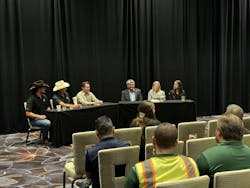DOE's 1st Tribal Loan Guarantee for Viejas Microgrid Will Spur Economic Development, Jigar Shah says
When the Department of Energy’s (DOE) Loan Programs Office (LPO) last week closed on its first tribal loan guarantee – up to $72.8 million for a solar plus long- duration energy storage microgrid – the agency paved the way for increased economic development for a California tribe, said Jigar Shah, director of the LPO in an interview with Microgrid Knowledge.
The community microgrid will be located on the tribal lands of the Viejas (Baron Long) Group of Capitan Grande Band of Mission Indians of the Viejas Reservation near Alpine, California. The microgrid will serve the Viejas Band’s commercial businesses, including gaming, hospitality and retail facilities, as well as serving as an emergency shelter for the community during public safety power shutoffs (PSPS) and outages. And it will provide energy sovereignty for the Viejas Band. The microgrid was funded in part by a California Energy Commission (CEC) grant for demonstrating long-duration energy storage.
“When you think about what the project represents for the Viejas Band, they have an extraordinary economic development opportunity,” said Shah. The casino is doing well, the tribe is adding electric vehicle chargers, and now – at a time when it’s difficult to obtain extra energy capacity from the utility, San Diego Gas & Electric (SDG&E) – the tribe is gaining extra capacity with the microgrid. And in the future, the tribe will benefit from offering energy services to its neighbors – including SDG&E – via the microgrid, he said.
The microgrid project is expected to create 250 construction jobs and eight permanent operations jobs. The focus will be on hiring tribal-, minority- and veteran-owned contractors, said a press release from the LPO.
Cutting energy costs with 15 MW of solar
In addition, the microgrid will save money on energy, funds that the tribe can funnel into its fire department and other priorities, Shah said. Key to the savings is a 15-MW solar system on the tribe’s carport that’s the largest of its kind, he added.
“There will be significant cost savings starting at year one and sustained through year 30,” said Nicole Reiter, vice president of development for developer Indian Energy, which is 100% Native American owned and operated. Indian Energy will own and operate the microgrid.
The savings come from the cost differential between power purchased from the local utility and the electricity generated by the carport solar photovoltaics system, she said.
Energy for the tribe now comes from the grid and diesel backup generators. While the tribe is required to have diesel as a backup source of energy, the diesel generators don’t have to be run when the microgrid is deployed, said Shah.
First tribal loan guarantee makes way for other tribes
The loan guarantee is the first to close under the Tribal Energy Financing Program. The Inflation Reduction Act boosted the available loan authority from $2 billion to $20 billion and provided $75 million to carry out the program in fiscal year 2022.
“The loan guarantee demonstrates a proof of concept and paves the way for other tribes to successfully complete the LPO loan guarantee process,” said Reiter. The total cost of the project will be about $150 million and Indian Energy and the Viejas Band have secured enough funding – including grants from the CEC – to cover the total cost.
Without the loan guarantee, the tribe would have to pay higher interest rates and the project might not pencil out, said Shah.
Long-duration energy storage will be demonstrated
The CEC provided a $31 million grant to demonstrate the potential of a 70-MWh long-duration energy storage system that includes a combination of 10-MWh vanadium flow batteries from Invinity Energy Systems and 60 MWh of EOS Energy Enterprises aqueous zinc batteries, said Reiter. The tribe needs long-duration storage – of eight to 12 hours – to meet its needs, said Shah.
“The CEC provided a grant that allowed Indian Energy to put in next-generation batteries,” he said. “That’s an important signal to other tribes that this loan program is open for business,” said Shah.
Long-duration storage is best-suited for applications in which power is needed for longer time frames or for when renewables or distributed energy resources aren’t producing power. And these technologies can bring added resiliency to microgrids.
In California, where wildfires are sparking outages and PSPS events, the CEC is working with Indian Energy to learn as much as possible about long-duration energy storage technologies through a number of grants.
The microgrid project is supported by investments from U.S. Bancorp Impact Finance, a subsidiary of U.S. Bank, and Starbucks — Starbucks is a tax equity co-investor and renewable energy credit purchaser for the project, said Reiter.
“Historic” loan guarantee
The closing of the loan guarantee is “historic,” said Shah.
“It puts the Viejas Band of Kumeyaay Indians on the national energy map as the tribal leader in energy sovereignty,” said Reiter.
The tribal energy loan program was created by the Energy Policy Act of 2005, but it was not funded until 2017 and not fully implemented until 2021, said Shah.
The LPO has been reaching out to tribes to understand their energy needs, he added.
“Each tribe wants different things,” said Shah. “Some want utility scale solar and wind. Others are looking to pursue hydrogen or other clean energy. We’re excited about all of them.”
The microgrid’s services will be in demand from neighbors in the future, said Shah. That includes SDG&E, the town, California Independent System Operator and community choice aggregations.
“As the market matures, the microgrid will get more valuable to neighbors and they will pay for services,” Shah said.









